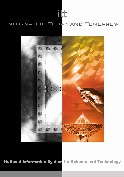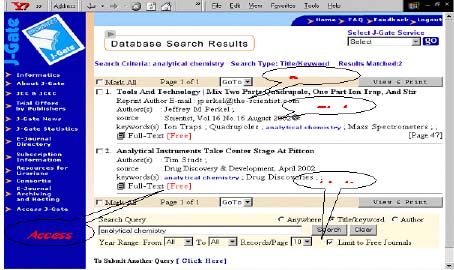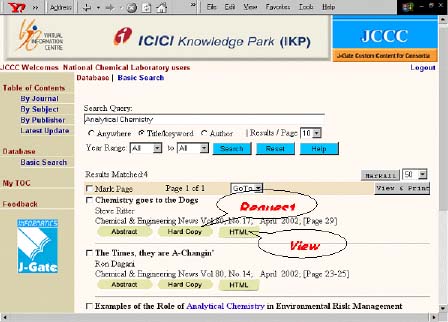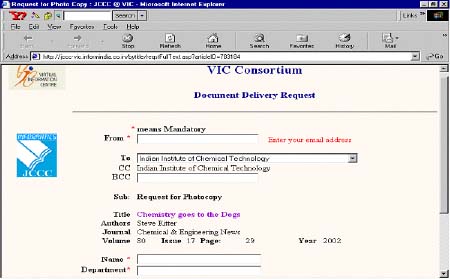
Vol 21 No 3 & 4 September & December 2002
T B Rajashekar
National Centre for Science Information
Indian Institute of Science, Bangalore-560012. INDIA
E-Mail: raja[at]ncsi[dot]iisc[dot]ernet[dot]in
ABSTRACT
Recounts the salient features of J-Gate; JCC - the library's local gateway; JCCC _ a resource sharing gateway for libraries; and JCCC[at]VIC - a NISSAT-funded initiative to promote resource sharing.
KEYWORDS: J-Gate; E-journal portal; Resource sharing.
INTRODUCTION
Internet and the Web are constantly influencing the development of new modes of scholarly communication. These include discussion forums, preprint archives, institutional Web sites and home pages. In spite of the increasing popularity of these channels for communicating and exchanging research results, the scholarly journal continues to be the most preferred and respected medium. The scholarly journal has become an integral part of the professional advancement of researchers. The peer review process and the associated recognition it bestows on researchers, and archiving of research results for long term availability are two characteristics that have made the scholarly journal stand apart from other media. The scholarly journal and associated services are themselves undergoing significant changes due to digital publishing technologies and Internet. The emergence of the e-journal has made the most significant impact. Apart from traditional publishers making available electronic versions of their journals on Internet, new e-journal service providers have surfaced. These include aggregators like Ingenta and Catchword, subscription-cum-aggregation agencies like EBSCO and Swets, portal-cum-aggregation services like Biomednet, and bibliographic-cum-document-delivery services like Infotrieve. Citation linking, across journals and from bibliographic to full-text articles, has been another major development. More importantly, digital publishing and Internet have brought down the time lag in article submission, acceptance and publishing workflow. New pricing models like pay-per-view and transaction-based models are also on the increase.
These developments, though exciting, have not brought marked improvements to the `bottom line' requirements of libraries and scholars. Libraries continue to lament on their inability to hold current subscriptions against increasing subscription costs and stagnating library budgets. The ever-growing number of journals has also complicated matters by making it difficult for scholars to simply find out what is published, let alone gain access to all relevant publications.
Services that aim to circumvent these problems and offer solutions are always welcome, particularly so if they are able to exploit current investments of libraries. J-Gate is one such major initiative in India, with which I was associated during its developmental phase in 2000. In this article I have made an attempt to briefly review the problems addressed and solutions offered by J-Gate and present features of major J-Gate related products. I also invite the readers to visit the J-Gate Website http://j-gate.informindia.co.in/ for more details.
INDIAN SCENARIO
Indian universities and research labs spend an estimated Rs. 200 crore a year on subscribing to international scholarly and research journals. This investment brings to the community of Indian scientists access to about 6,000 scholarly and research journals. However, Indian scientists continue to suffer from information poverty. An average Indian university library subscribes to less than 300 international journals. As a striking comparison, an average American or European university subscribes to more than 5,000 journals. Access-gap to journal literature is growing wider every year. Today we face two serious gaps.
Availability Gap: While the country as a whole subscribes to a significant number of journals, what is available at individual institutional level is a very small number. Resource sharing through library co-operation could have bridged this availability gap. But it did not take off in an organized manner for many reasons. Our libraries need an effective mechanism to share and optimally utilize available journal resources.
Access Gap: What is available is not accessible to users, particularly when needed, leading to a colossal wastage of investment. Libraries subscribe to journals. To help their users to find out the contents of these journals, libraries subscribe to bibliographic databases (indexing and abstracting journals). Without these databases, there is simply no way by which a user can search for the contents in the journals even if the journals are physically available. Over the years, the population of databases in our libraries has declined drastically. Most of our libraries today, and particularly university libraries, no longer have access to databases like BIOSIS, INSPEC, Georef, Current Contents, Chemical Abstracts, etc as these products have perceivably become unaffordable. Access to journal literature is inconceivable without a database. Our libraries definitely need a low cost database alternative and article level holdings to bridge this serious access gap.
J-Gate is the first major e-journal service initiative in India seriously trying to address these two gaps, keeping in view the specific needs of Indian scholars and libraries.
J-GATE _ THE FIRST E-JOURNAL PORTAL FROM INDIA
J-Gate is an e-journal portal and access gateway. It provides means of access to global literature in scholarly and research journals. J-Gate aims to help users in:
- Browsing table of contents (TOC) of 8,000+ e-journals
- Searching a reasonably well-indexed bibliographic database of journal articles from these e-journals.
- Locating a local library in India, where the article he finds from the search could be available.
- Sending e-mail to authors for a reprint-request.
- Accessing full-text of about 1,000+ free journals available online. J-Gate links to full-text of more than 100,000 currently published articles since 2001, which are freely available.
Every bibliographic record in J-Gate is linked to a full-text article on publisher's site. Libraries who subscribe to e-journals will find J-Gate as a means to have seamless access to their subscribed journals' content. For journals the library does not subscribe, the users have an option to either send an e-mail request to authors using the author e-mail address included in the bibliographic record, or identify a local library through J-Gate's union-catalog icon. Figure 1 presents a set of typical bibliographic records retrieved from a J-Gate search.

Figure 1: A typical bibliographic record
JCC _ THE LIBRARY'S LOCAL GATEWAY
Libraries have a responsibility to help their users to search and find the journal literature available within the journals they subscribe. A local database that indexes all the articles from all the research journals the library subscribes is an essential need, particularly in a situation where the libraries do not or cannot afford to subscribe to international bibliographic databases.
In the e-journal environment, libraries need a publisher-independent, single-point gateway for accessing the e-journals they subscribe. If a library is subscribing to, say 200 e-journals, their content will be scattered across several publisher sites. Without a local gateway that enables cross searching across the publishers' sites, the user will be lost. Most publishers do not even provide search facility at their sites. Further, libraries need to manage the access codes (user ids and passwords) for many e-journals.
J-Gate Custom Content (JCC) acts as a local database and gateway for searching and accessing locally subscribed journals _ both print and electronic. The concept is based on S R Ranganathan's local documentation list! The major benefit of JCC is its ability to maximize the usage of the journals subscribed by the library. A tool like JCC does not exist today in most of our libraries. Informatics claims this to be their Online Journal Access Catalog (OJAC) model for accessing journal literature available within the library. Several user surveys and Internet and intranet use studies of students, researchers and business executives have shown that users prefer to use information that is easy to locate and readily available [1-4]. JCC is an effective tool that can surely place before the user library's entire journal literature content for quick and convenient searching.
While J-Gate is a global solution, JCC is a local solution. JCC content and the software will reside in Library's LAN/Intranet. Bibliographic content is updated every week by Informatics. The user can browse the Table of Contents (TOC) and search the database of library's subscribed journals. Since the links are provided at the article level for all articles from e-journals, the user can instantly access full-text when he finds an article of his need from JCC database search.
There are two differences that distinguish JCC from J-Gate. JCC covers both print and online journals subscribed by a library. Thus JCC acts as an article level index and holdings of a library's journals. J-Gate index does not reflect holdings of any specific library but indexes articles from 8,000+ e-journals, excluding print journals. Secondly, J-Gate is an Internet service while JCC is an intranet service.
A library will find the real value of JCC as the years go and the JCC contents cumulate. A library as that of the Indian Institute of Science subscribing to 1,000+ journals would have a JCC database of about 500,000 records in five years time as a searchable index for journal content within the library. The biggest gain of such an index can come from maximized usage of journal literature available within the library. Such usage is marginal today because users do not have access to article-level holdings of the library. JCC is currently available from 2001 onwards. It will be useful to customize it further to cover back year's content of a library, at a cost our libraries can afford. Informatics may find it useful to initiate this as a separate project.
JCCC _ A RESOURCE SHARING GATEWAY FOR LIBRARIES
JCCC is an extension of JCC for Library Consortia. Informatics has aptly named it as JCC for Consortia (JCCC). The unique and additional value of JCCC comes from its innovative ability to facilitate resource sharing and promote consortia development in an organized manner.
JCCC is a sharable database of common bibliographic content for articles published in the journals that all the libraries in a consortia subscribe. To enable sharing full-text, JCCC incorporates the union catalog of journals into JCCC database. It acts as a common gateway or a private portal for the consortia members.
By its very design and availability of common content base, JCCC empowers users to directly reach out to the library where the journal is available. When a user finds articles of his need from a JCCC search, a click on "Hardcopy" button sends an email to the library, which has the journal and is designated to provide photocopy of the article under the resource-sharing agreement.
In case of journals available online, if the library obtains the right of online access, the user can view the article on his screen. Publishers should find JCCC as a useful gateway as it encourages libraries to go more aggressively for e-journal consortium to expand the online access through a local gateway.
An attractive feature of JCCC is the facility it has provided for rights management required in an online environment. If two libraries in a consortium subscribe to the same journal, and one of them has online access rights, online links are shown to users of this library only. These links are not available to the library, which has only print subscription. This way security and license concerns of publishers are taken care of by JCCC.
JCCC[at]VIC - A NISSAT-FUNDED INITIATIVE TO PROMOTE RESOURCE SHARING
Informatics launched the first formal and organized resource-sharing consortium, using JCCC as the basis, on 1st July this year. The client is the Virtual Information Center (VIC) at ICICI Knowledge Park (ICICI-KP). The Knowledge Park is a very sophisticated international research infrastructure promoted jointly by Andhra Pradesh Government, ICICI and the Department of Scientific and Industrial Research (DSIR). A challenge that confronted ICICI-KP was providing access to its users in the park for research information in several diverse areas from biotechnology to information technology. It found a solution to this challenge in the concept of JCCC, which was undergoing development during early this year. Encouraged and funded by NISSAT, VIC at ICICI-KP used the concept of JCCC to promote and translate this concept into a "networked resource sharing consortia for journals". Seven institutions including ICICI-KP that currently participate in this consortium are:
- Virtual Information Center (VIC), ICICI Knowledge Park, Hyderabad - (Consortium Leader)
- University of Hyderabad
- Indian Institute of Chemical Technology, Hyderabad
- Center for Cellular and Molecular Biology, Hyderabad
- National Institute of Nutrition, Hyderabad
- ICRISAT, Hyderabad
- National Chemical Laboratory, Pune
The consortium selected 500+ journal titles subscribed by one or several of the members. JCCC is a central database and gateway for the bibliographic content of these 500+ journals, updated regularly. It is a simple concept with a complex design behind. The value that JCCC provides today to its consortium members can be best explained in the following example providing multiple scenarios for resource sharing.
The user at University of Hyderabad logs in to VIC and makes a search on biopolymers. Out of several articles found in the search, let us say the user selects two articles as relevant to his needs. He needs quickly full-text of these two articles. JCCC helps him in obtaining the full-text in the following two ways.
The 1st article from his search shows full-text or PDF online button which indicates that user's library has an online subscription or access rights. He clicks on this button to fetch the article instantly to view on his screen.
The 2nd article shows hardcopy button but does not show online buttons. When he clicks on hardcopy button, an e-mail request is triggered directly to the library that is designated for document delivery. The library sends the photocopy of the article to the user from its print collection. (This library could be user's own library or any one of the member libraries in the consortium. If the journal is available in user's library, there is an optional facility to request the user to visit the library instead of showing e-mail screen.)
Figure 2 and Figure 3 shows result display of a JCCC[at]VIC search by a user and document delivery request interface, respectively.
The mode of access for each journal is configurable by each member library depending on its access rights _ online or print, user id/ password or IP enabled, etc. This configuration at the individual library level enables effective rights management by each library for e-journal access, which is a critical need in a resource sharing consortium.

Figure 2: Result display of a JCCC[at]VIC search by a user interface

Figure 3: Result display of a JCCC[at]VIC search by a document delivery request interface
I am informed by Informatics that INFLIBNET has made an announcement to implement JCCC for five university libraries on an experimental basis. The MHRD consortium is also said to have chosen JCCC as a resource-sharing and access gateway for the journals subscribed by all IITs and IISc, with an additional provision for providing bibliographic level access to twenty Regional Engineering Colleges (now called National Institutes of Technology).
JCC and JCCC were developed after I had left Informatics for my sabbatical. Originally, it was conceived as J-Gate OnSite, a solution with a much larger capability to provide complete e-journal management solution for a digital library environment. JCC and JCCC are the early spin-off from this idea of J-Gate OnSite. As someone involved in the conception of J-Gate, I find JCC and JCCC as truly path-breaking innovations that hardly find any parallel today.
INDEXING AND CLASSIFICATION
J-Gate production system today captures basic bibliographic content and link information for about 25,000 articles a week, which adds up to an estimated 12 lakhs articles a year. Indexing such a massive base quickly and cost effectively to keep the product cost low is a major challenge that we faced during product design. Using the kind of indexing model followed by INSPEC or BIOSIS would have significantly pushed the cost of indexing, besides creating time-gap in making available the content. A database without a good index cannot be called a database at all as it will be weak in its searchability and precision in retrieval. To keep the cost low and yet provide a convenient tool for searching, the following two innovative indexing and classification models were developed.
Semi-automated Indexing. We developed a large authority list of about 150,000 keywords. The software was developed to identify appropriate keywords for every article by matching titles and abstracts against this authority list. The terms thrown up by the software for every article are further reviewed by an index-editor with broad subject background of the discipline of the article. The review process selects the most appropriate keywords, including addition of keywords that the software has failed to notice. This novel combination of computing power at mass level and human judgment at a finer level has resulted in a reasonably good quality indexing system for the database. While the software may throw up 10-15 keywords, the indexer selects about six to eight keywords for each article.
Classification. For a large database of J-Gate size, covering all disciplines in science, technology and social sciences, a broad classification system is inescapable. Here again, the cost of classification for every article became a major challenge, apart from evolving a suitable classification system. We evolved an innovative system of classifying journals at two levels instead of classifying each article. The assumption here is _ a journal in biotechnology is unlikely to present articles totally unrelated to biotechnology. We evolved a classification system and classified each of the 10,000+ journals. A journal may get assigned more than one classification group, often up to three. In J-Gate portal search today, the user can select a subject category like Pediatrics and use appropriate keywords to represent his subject concepts. This will result in limiting the search to journals in Pediatrics and related journals. We know this is not a very perfect solution, but is capable of reducing considerable noise from search results.
FREE JOURNALS
A unique and innovative concept followed in J-Gate is indexing e-journals available free on the Web. There are many Web sites today that list free journals on the Web. But these are mere journal listings with link to journal site. J-Gate is perhaps the only portal which indexes the articles published in free e-journals as an organized database creation activity and provides the user the facility to identify whether a retrieved article is available free on the Net or not. Currently, out of over 12 lakh articles indexed on J-Gate, more than 150,000 articles are available free to users for access. This is one of the major value additions of J-Gate that is of immense benefit to the users.
CONCLUSION
J-Gate is probably the most ambitious venture of its type in India, involving massive content gathering, organizing and management. It is also a well-thought-out e-journal portal service with great potential to scholars and libraries in the country. I believe and hope that Informatics will leverage on this initiative to come out with related services of great use and importance. These could include: personalized content delivery, integration with other high-quality open access (free) to scholarly content available on the Web, low-cost subject-specific bibliographic collections, third-party archiving solution, and aggregation and hosting of Indian e-journals. Consideration also needs to be given for adopting relevant best practices and standards for information organization and delivery. Some of the technical challenges include maintenance of link currencies, development of automatic approaches to intelligent information organization and searching, and provision of reliable service within reasonable response and turn-around times. Most importantly J-Gate has to be constantly in touch with the needs of the targeted user community and respond to these in a proactive manner.
REFERENCES
- Bjork B, Turk Z. How scientists retrieve publications: an empirical study of how the Internet is overtaking paper media. Journal of Electronic Publishing 2002; 6(2). (http://www.press.umich.edu/jep/06-02/bjork.html)
- OCLC white paper on the information habits of college students (http://www2.oclc.org/oclc/pdf/printondemand/infohabitsverbatim.pdf)
- Pinelli TE. The information-seeking habits and practices of engineers. Science & Technology Libraries 1991: 11(3): 5-25.
- Managing online information to maximize corporate intranet ROI, by Outsell, Inc. Survey of 6,400 knowledge workers by Outsell, Inc. July 2001. (http://www.outsellinc.com)
Information Today & Tomorrow, Vol. 21, No. 3 & 4, September & December 2002, p.3-p.8 & p.10
http://itt.nissat.tripod.com/itt02034/jgate.htm





















